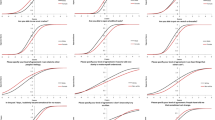Abstract
Purpose
To expand content of the physical function domain of the Work Disability Functional Assessment Battery (WD-FAB), developed for the US Social Security Administration’s (SSA) disability determination process.
Methods
Newly developed questions were administered to 3532 recent SSA applicants for work disability benefits and 2025 US adults. Factor analyses and item response theory (IRT) methods were used to calibrate and link the new items to the existing WD-FAB, and computer-adaptive test simulations were conducted.
Results
Factor and IRT analyses supported integration of 44 new items into three existing WD-FAB scales and the addition of a new 11-item scale (Community Mobility). The final physical function domain consisting of: Basic Mobility (56 items), Upper Body Function (34 items), Fine Motor Function (45 items), and Community Mobility (11 items) demonstrated acceptable psychometric properties.
Conclusions
The WD-FAB offers an important tool for enhancement of work disability determination. The FAB could provide relevant information about work-related functioning for initial assessment of claimants; identifying denied applicants who may benefit from interventions to improve work and health outcomes; enhancing periodic review of work disability beneficiaries; and assessing outcomes for policies, programs and services targeting people with work disability.



Similar content being viewed by others
References
Institute of Medicine (IOM). (2007). The future of disability in America. Washington, DC: The National Academies Press.
Institute on Disability. (2016). 2015 annual disability statistics compendium. Durham, NH: University of New Hampshire.
Social Security Administration. (2014). Annual statistical report on the Social Security Disability Insurance program. Accessed April 21, 2016.
Institute of Medicine (IOM). (2007). Improving the social security disability decision process. Washington.
Haley, S., Ni, P., Jette, A., et al. (2009). Replenishing a computerized adaptive test of patient-reported daily activity functioning. Quality of Life Research, 18(4), 461–471.
McDonough, C. M., Jette, A. M., Ni, P., et al. (2013). Development of a self-report physical function instrument for disability assessment: Item pool construction and factor analysis. Archives of Physical Medicine and Rehabilitation, 94(9), 1653–1660.
Ni, P. S., McDonough, C. M. J. A., Bogusz, K., Marfeo, E. E., Rasch, E. K., Brandt, D. E., et al. (2013). Development of a computer-adaptive physical function instrument for Social Security Administration disability determination. Archives of Physical Medicine and Rehabilitation, 94, 1661–1669.
Marino, M. E., Meterko, M., Marfeo, E. E., et al. (2015). Work-related measures of physical and behavioral health function: Test–retest reliability. Disability and Health Journal, 8(4), 652–657.
Meterko, M., Marfeo, E. E., McDonough, C. M., et al. (2015). Work disability functional assessment battery: Feasibility and psychometric properties. Archives of Physical Medicine and Rehabilitation, 96(6), 1028–1035.
Marfeo, E. E. H. S., Jette, A. M., Eisen, S. E., et al. (2013). A conceptual foundation for measures of physical function and behavioral health function for Social Security work disability evaluation. Archives of Physical Medicine and Rehabilitation, 94, 1645–1652.
World Health Organization. (2001). International classification of functioning, disability and health (ICF). Geneva.
Rivers D. (2006). Sample matching: Representative sampling from internet panels. A white paper on the advantages of the sample matching methodology. Palo Alto, CA: Polimetrix, Inc.
Thompson, B. (2004). Exploratory and confirmatory factor analysis: Understanding concepts and applications. Washington, DC: American Psychological Association.
Hu, L., & Bentler, P. M. (1995). Evaluating model fit. In R. H. Hoyle (Ed.), Structural equation modeling: Concepts, issues and applications. Thousand Oaks, CA: Sage.
Hu, L. T., & Bentler, P. (1999). Cutoff criteria for fit indices in covariance structure analysis: Conventional criteria versus new alternatives. Structural Equation Modeling, 6, 1–55.
Steiger, J. H. (1990). Structural model evaluation and modification: An interval estimation approach. Multivariate Behavioral Research, 25, 173–180.
Samejima, F. (1969). Estimation of latent ability using a response pattern of graded scores. Psychometrika Monograph, 17(Suppl), 1–100.
Orlando, M., & Thissen, D. (2003). Further investigation of the performance of S-X2: An item fit index for use with dichotomous item response theory models. Applied Psychological Measurement, 27, 289–298.
Thissen, D. (2009). The MEDPRO Project: An SBIR project for a comprehensive IRT and CAT software system-IRT software. Paper presented at GMAC conference on computerized adaptive testing, Minneapolis, MN.
Scientific Software International. (2011). IRTPRO: Flexible, multidimensional, multiple categorical IRT modeling [computer software]. Lincolnwood, IL.
Langer, M. (2008). A reexamination of Lord’s Wald test for differential item functioning using item response theory and modern error estimation. Chapel Hill: University of North Carolina.
Woods, C., Cai, L., & Wang, M. (2013). The Langer-improved Wald test for DIF testing with multiple groups: Evaluation and comparison to two-group IRT. Educational and Psychological Measurement, 73, 532–547.
Edelen, M., Stucky, B., & Chandra, A. (2015). Quantifying ‘problematic’ DIF within an IRT framework: Application to a cancer stigma index. Quality of Life Research, 24(1), 95–103.
Green, B. F., Bock, R. D., Humphreys, L. G., Linn, R. L., & Reckase, M. D. (1984). Technical guidelines for assessing computerized adaptive tests. Journal of Educational Measurement, 21, 347–360.
Acknowledgements
This study was supported by Social Security Administration-National Institutes of Health Interagency Agreements under the National Institutes of Health (Contract Nos. HHSN269200900004C, HHSN269201000011C, HHSN269201100009I, HHSN269201200005C), and by the National Institutes of Health Intramural Research Program.
Author information
Authors and Affiliations
Corresponding author
Ethics declarations
Conflict of interest
The authors declare that they have no conflict of interest.
Electronic supplementary material
Below is the link to the electronic supplementary material.
Rights and permissions
About this article
Cite this article
McDonough, C.M., Ni, P., Peterik, K. et al. Improving measures of work-related physical functioning. Qual Life Res 26, 789–798 (2017). https://doi.org/10.1007/s11136-016-1477-1
Accepted:
Published:
Issue Date:
DOI: https://doi.org/10.1007/s11136-016-1477-1




